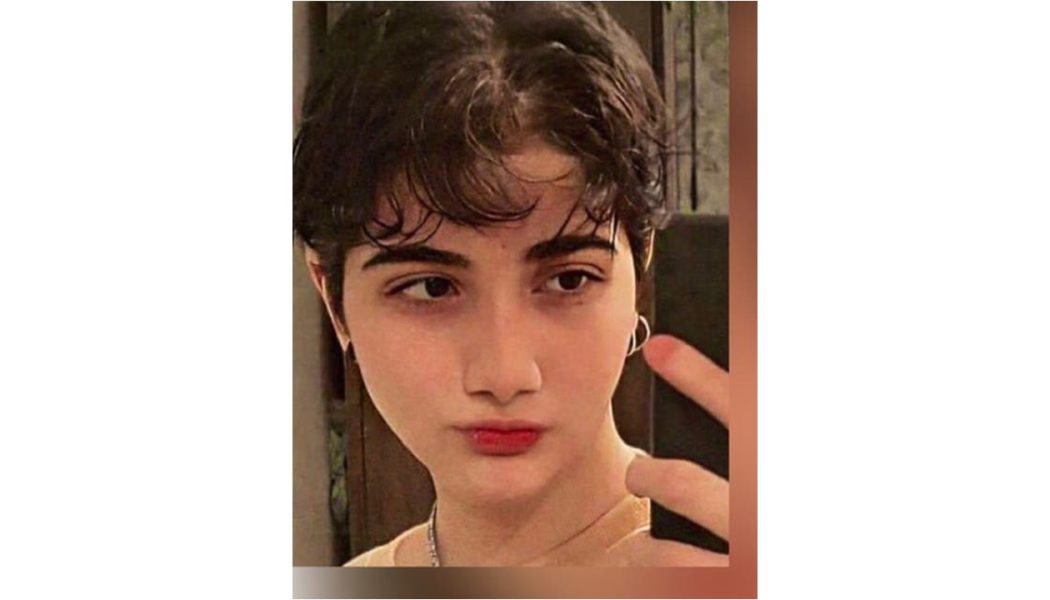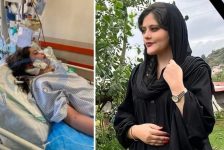Armita Geravand, born on April 2, 2006, and tragically passing away on October 28, 2023, was an Iranian girl who found herself hospitalized on October 1, 2023, following an incident within the Tehran subway system. Sadly, she was knocked unconscious and sent to the Army University of Medical Sciences’ Fajr Hospital for admission. Then, following a horrifying twenty-eight days, she entered a coma and passed away from the hit. Armita Geravand was a student in the eleventh grade at the time, attending a conservatory in Tehran.
The precise circumstances of her ordeal on the train, often known as the metro, are yet unknown. There was no physical attack, according to the Islamic Republic of Iran’s officials and state-run media. However, other media sources—like Iranwire, The Guardian, and Radio Farda—have referenced eyewitness reports that paint a different picture of what happened. These reports state that Armita and a female hijab enforcement Police got into an argument about the hijab’s mandatory wear not long after she arrived at the Shahada Square metro station and entered the train.
Conflicting Accounts and Speculations
The teenager was then taken to Fajr Military Hospital, which is managed by the Air Force in Tehran, where she was received by emergency response staff and is located near the Shahada metro station. Details of her unconsciousness—which was allegedly caused by a violent struggle with law enforcement officials—were shared on social media the following Monday.
As soon as the metro President concurrently published a video statement on Monday, October 2, speculation and supposition about this young person started to circulate. The statement disclosed that a 16-year-old female student had boarded the train on Line 4 of the Shahada Square subway on Sunday, October 1, at 7:00 a.m. Her incapacitation was a result of a fall, and her hypotension caused her to go unconscious. It is noteworthy that the aforementioned person was later helped by her friends and an additional train passenger—presumably a medical practitioner. He added, “The executive officers of the metro started treating him right away, and they also requested emergency assistance at the same time. As soon as the emergency crew got on the scene, they stabilized the girl’s condition and brought her to the hospital.” According to him, there was no verbal or physical altercation between the student and the subway executives.
Release of the Uncertain Video Footage and Pressure on Armita’s Family
This student was seen being hauled out of the metro car with the assistance of her companions in the first footage that the Tehran Metro released. She is pulled from the wagon, appearing to be unconscious. However, the release of this video raised more questions than it answered. Some people on social media questioned why film from the instant before the incident had not been made public.
The fact that there was no discernible timestamp on the film cast more doubt on its veracity. These doubts were increased when information about the detention of journalist Maryam Lotfi, who works for the Shargh daily, surfaced. Representatives for the newspaper claimed that Lotfi had gone to the Fajr Hospital in eastern Tehran to write up a report on the incident, but that he was stopped by security personnel. The report he was working on was never published, even though he was later freed on Monday night.
A number of journalists claimed on Twitter that Lotfi had been arrested while speaking with the mother of the student. As a result of this occurrence, the student’s parents had to appear in front of government media cameras the following Tuesday.
“I am inclined to doubt the prevailing narratives,” the young girl’s parents said in front of the state-run IRNA camera on Tuesday. The girl’s identity had not been revealed earlier.
Later, the mystery was increased by the publication of an interview that Armita’s mother had with the press agency of the Islamic Republic of Iran. “My daughter, I believe… the blood pressure… the blood pressure has subsided, I am not sure how… to perceive, they are now asserting that the blood pressure has been alleviated,” among other cryptic statements she used in the interview added to the suspicions of journalists and curious citizens about the possibility of a “coerced confession” in this interview. Such incidents have a well-documented history inside the Islamic Republic’s security forces.
Following the disclosure of the details pertaining to this young girl, the Tehran Metro officials made available a second video that provided a different account of what happened that tragic day. However, the interior of the subway train is not shown in this video. It showed a group of female students waiting for the subway to arrive on the station’s seating area, recorded by cameras positioned on the opposite platform. The metro train arrives on both sides at the same time, and the film then cuts to the previously released clip, which shows the students getting on and off the train as well as the scene where Armita was taken off of it. Notably, the camera on the side from which the students embarked fails to reveal the moments preceding their boarding.
The Iran International Network said a few days ago, on October 16, 2023, that Armita’s parents had received a summons to the office of Delavar Al-Qasi-mehr, the provincial police commander of eastern Tehran, in the last few days. They were asked to present a signed commitment there promising not to file complaints against any people, groups, or establishments.
The Guardian’s Eyewitness Accounts
In an interview with The Guardian newspaper on October 5, two witnesses to the events confirmed an incident involving Armita’s headscarf. In early 2023, Tehran Mayor Alireza Zakani announced the installation of a municipal security unit in the city’s metro stations. The unit’s main goal is to prevent people who are discovered to be breaking any laws in the Islamic Republic from entering the subway system by handling them proactively. One of these witnesses claimed that as Armita got in the train, a Hijab policewoman chastised her and they got into a furious dispute over not wearing one. The witness recalled that the veiled woman shouted, ‘Why aren’t you wearing a hijab?’ to which Armita responded, ‘Shall I tell you why you don’t remove your hijab?’
According to The Guardian, which quoted this eyewitness, the verbal argument turned into a physical fight in which the person wearing the hijab attacked and shoved Armita. Another eyewitness claimed in the Guardian story that “Armita remained conscious after falling to the ground.” “The exact same hijab-wearing woman was present near the ambulance’s entrance when the Tehran emergency department was in the process of transporting Armita to the hospital,” the eyewitness told The Guardian.
Tragic End and Official Medical Explanation
Before this, on October 12, Hengaw, a human rights organization, issued a statement based on information gathered from its sources. It turned out that once Armita’s condition was assessed, six doctors were not optimistic about her chances of recovery. Hengaw news reports that Armita’s family was informed by the medical staff at Fajr Hospital that “it is exceedingly improbable to restore their child’s health.”
For the entire 28 days that Armita was admitted to Tehran’s Fajr Air Force Hospital, no official medical report regarding her status was provided. The hospital remained a security-focused facility, and official news reports on the incident were under to strict security controls, with IRNA being the only outlet allowed exclusive access.
Conflicting information about Armita’s condition was circulating for the duration of her coma. The strain on Armita’s family increased after a photo of her in the intensive care unit of Tehran’s Fajr Hospital was posted on social media. The family members of Armita had their cell phones examined since they might have shared the picture. Furthermore, according to the Coordinating Council of Trade Union Organizations of Iran, the Ministry of Education’s security chief threatened Armita’s teachers and classmates, ordering them to stop sharing any information or images of her.
After spending 28 days in the intensive care unit of Fajr Hospital, Armita passed away on October 28, 2023. The official news agency of the Iranian government, IRNA, made the announcement of her death. IRNA reports that the official medical explanation for her illness blamed a fall for the brain injury, ongoing seizures, decreased cerebral oxygenation, and cerebral edema that followed a sharp drop in blood pressure. Human rights activists claim that she was beaten and put into a coma as a result of an encounter with the Islamic Republic’s Hijab Police.
Stirring Public Fury & Global Response to the Tragedy
Strict security precautions were in place for the burial, and security agents intervened throughout the ceremonies, which turned violent. A few guests suffered violent attacks, while some others were taken into custody. Not long after Armita’s death was announced, her name shot to the top of the Twitter trending list, drawing comments from a wide range of civil, political, and cultural personalities. Many people, both common users and well-known political and artistic leaders, from Iran and elsewhere, described her death as “state-sanctioned murder” and made analogies to the events surrounding Mahsa Amini’s passing.
Germany’s Foreign Minister Annalena Baerbock responded to this problem by saying, “Once again a young woman in Iran is fighting for her life. Just because she showed her hair in the subway. It is unbearable.” And the last Iranian king’s son, Reza Pahlavi, also remarked on the occurrence, saying, “Those who killed Mahsa Amini are the same ones who killed Armita. The battle between us and them is a battle between good and evil, and until we win this battle they will kill us and there will be no justice. Onward, together, towards victory for Iran.
The Urgent Call for Change and Justice
The case of Armita, a young Iranian student who found herself at the center of a tragic incident on the Tehran subway system has left many things unanswered and sparked a firestorm of outrage. There have been accusations and worries regarding her hospitalization and death after an apparent fight with hijab enforcement Police. Different stories have emerged regarding what happened to put her in a coma and cause her to die suddenly. Doubting reports, tight security measures, and a lack of openness have all contributed to the growing suspicions surrounding the case. Human rights organizations argue that Armita was injured in a confrontation with the Islamic Republic of Iran’s Hijab Police, despite official accounts pointing to a fall that caused a brain injury and other medical issues.
Doubts over the actual nature of the events have been heightened by the pressure and scrutiny Armita’s family and those who attempted to shed light on the occurrence have faced. Social media users have taken notice of the tragedy and responded with condemnation of the way young women are treated in Iran and demands for justice from prominent figures worldwide.
The Islamic Republic’s larger problems with accountability, freedom of speech, and individual rights are brought to light by the tragic case of Armita. The ongoing dispute surrounding her case serves as a sobering reminder of the difficulties and complexities encountered by individuals seeking justice and transparency in circumstances where the truth may be obscured by official narratives and security measures.
The outpouring of support and condemnation from global figures, as well as the public’s outcry, emphasizes the need for change and justice. Armita’s story serves as a poignant reminder of the ongoing struggle against tyranny, where truth and justice often face formidable obstacles.









